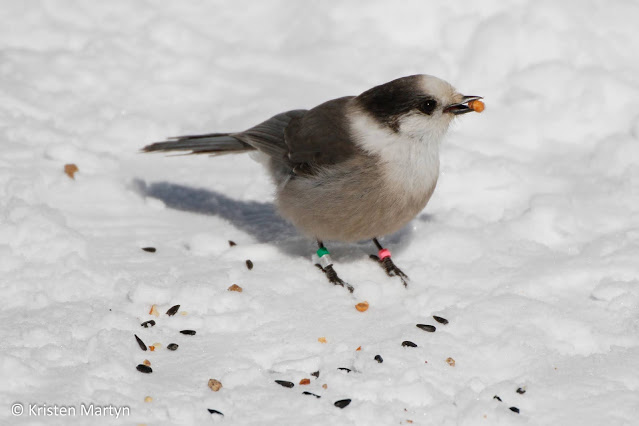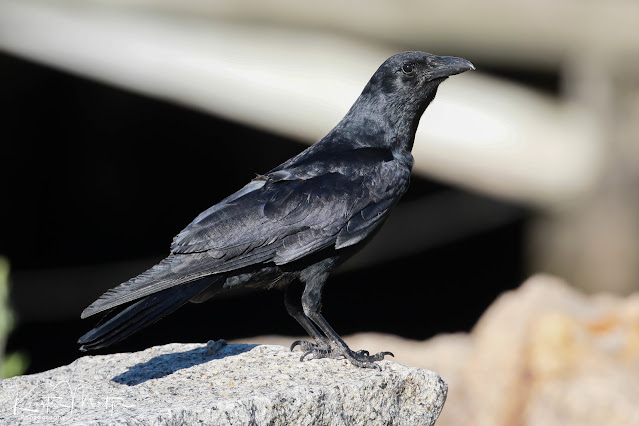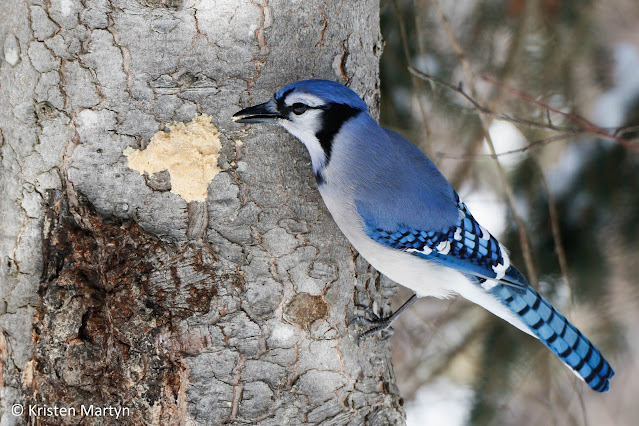 |
| Clark's Nutcracker |
1. Blue Jays and Canada Jays are part of the Corvidae family.
Corvids aren't all crows and ravens. Corvids are large passerine birds that are typically fitted with a stout bill & robust legs, have omnivorous and opportunistic feeding habits, raise their young in open nests, and a high level of intelligence. The Corvidae family currently consists of 133 species which include all jays, nutcrackers, rooks, jackdaws, magpies, treepies, choughs, crows, and ravens. Of those 133 species, Ontario is home to just four: American Crow, Common Raven, Blue Jay, and Canada Jay.
2. Ravens are one of the most adaptable birds on the planet.
Adaptability is essential for survival in our ever-changing climate, and ravens have it mastered. Ravens can live in nearly any type of environment, from frigid temperatures to dry dessert heat, forests to mountains and beyond. As scavengers and opportunistic feeders, ravens can adapt their diet to suit any habitat feeding on a variety of foods including carrion, fish, seeds, fruit, insects, frogs, garbage, and more. Because they have few natural predators, ravens are capable of living long lives in the wild, up to 17 years old.
 |
| Canada Jay |
3. Canada Jays have an all natural solution for keeping caches of food well hidden.
Many birds cache seeds in preparation for food scarcity in the winter, but Grey Jays like to do things a little differently than most. Before each food item is cached, Grey Jays coat their food with an ample amount of sticky saliva that is secreted from their extra-large salivary glands. This sort of built-in glue helps ensure that the food items are held securely in their hiding places until the Grey Jays return for them.
4. Crows have funerals for their fallen.
It's unknown whether crows have emotional intelligence (though ravens are believed to experience empathy), but they will sometimes visit the corpse of a deceased crow for several days. It's believed this is to assess the reason the bird passed, helping them gain knowledge to stay safe in the future.
5. Blue Jays aren't actually blue.
Blue is a very fascinating and rare colour in nature because most animals cannot make blue pigments, often it is just the structure we are seeing and how it reflects light. Most of the blue that we see in birds, such as Blue Jays, is actually due to feather structure and the way that light reflects on them. When light shines on a Blue Jay, all other wavelengths of the colour spectrum (a rainbow) are absorbed. So the colour we see - in this case, blue - is reflected back to our eyes. Producing colours structurally is how nature has hacked "making blue". Blue jays are not the only ones, any bird that we identify as blue including Indigo Buntings and Eastern Bluebirds have no blue pigment. Click here to learn more about Blue in Nature.
6. Ravens have a playful side.
Ravens have been observed in many areas of the world participating in play-like activities. Using snow-covered roofs as slides, intentionally rolling down hillsides, using objects to play keep away with other animals including otters and domestic dogs, and some have even been observed making their own toys out of sticks and pinecones or rocks to play with one another or alone.
 |
| Fish Crow |
7. Baby crows are "colour-coded".
Baby crows are "colour-coded" with two distinct features that allow us to recognize juvenile from adult. One of those features is their bright blue eyes, which will transform to a deep brown as they age, and the other being the pink gape (inside of mouth and fleshy area around bill), which is used to attract parent birds' attention in order to encourage feeding. Unlike many birds, American Crows do not chase away their offspring when they are self-sufficient. Instead, they live in family groups with each generation helping to raise they next until they are of breeding age, typically four or more years old. Some studies have shown that even after a crow has left its family, the bond may remain for several years with some individuals occasionally returning to their family group to visit.
 |
| Blue Jay |
8. Ravens are highly skilled mimics.
Parrots are typically thought of as the greatest mimics in the bird world, but ravens can talk with the best of them. Common Ravens can learn to mimic even better than most parrot species, and are capable of learning human voices, car engines and other mechanical sounds, and bird & animal calls. They've even been noted to imitate wolf or coyote calls to lure them to carcasses that the ravens themselves are unable to break into, and scavenge on the meat once another predator has freed the meat.
Happy trails!
- Shayna
















No comments:
Post a Comment